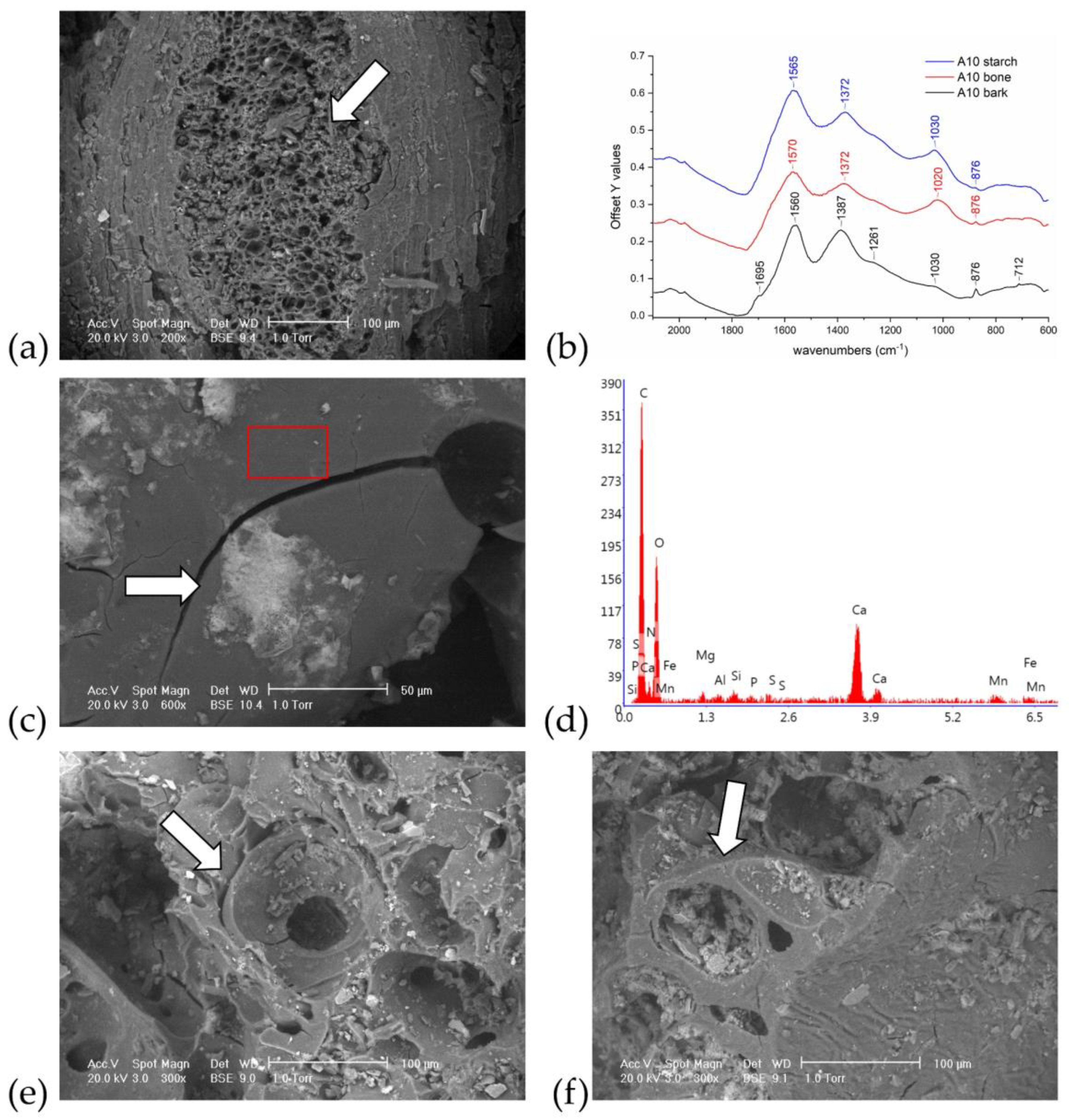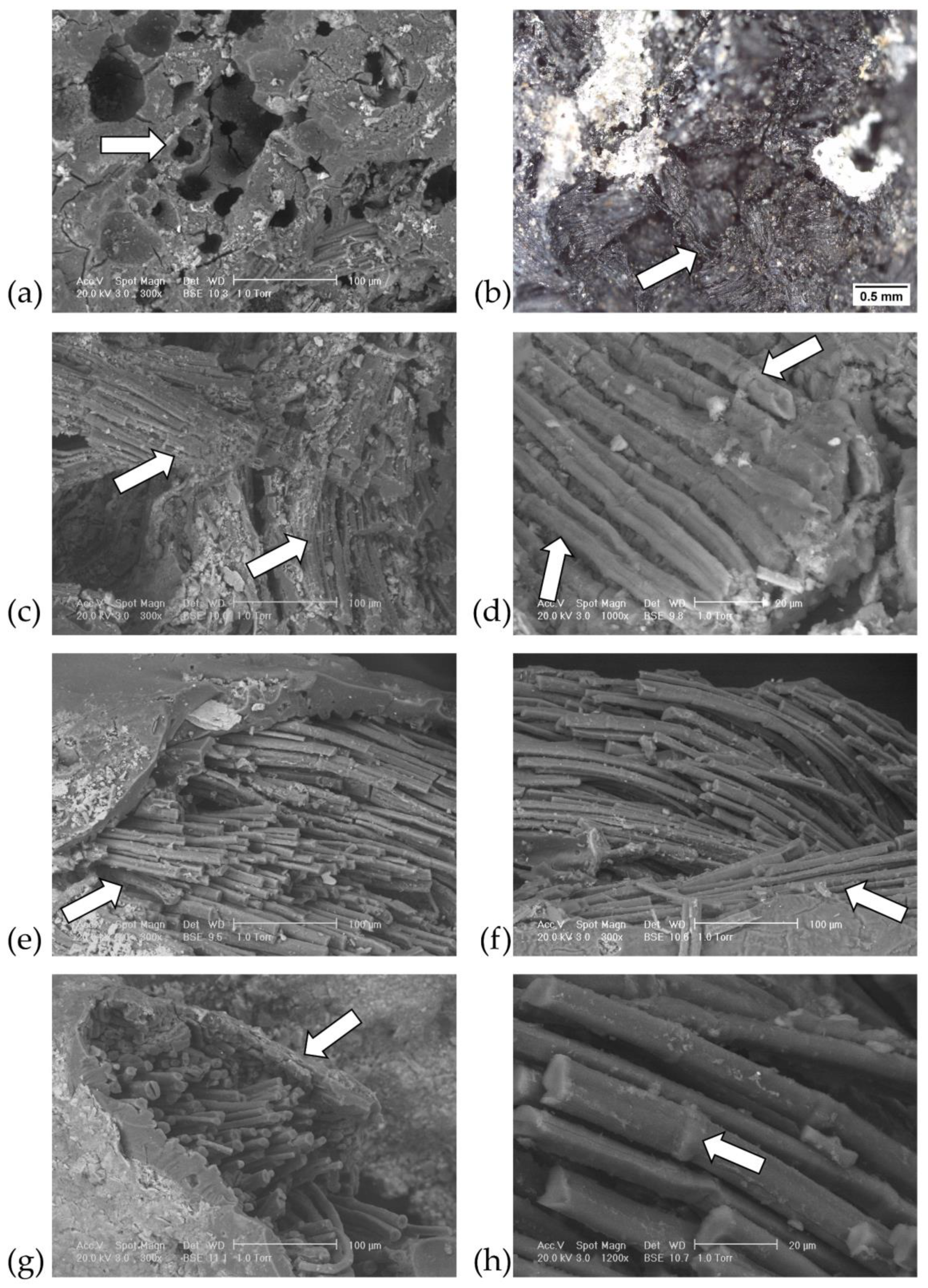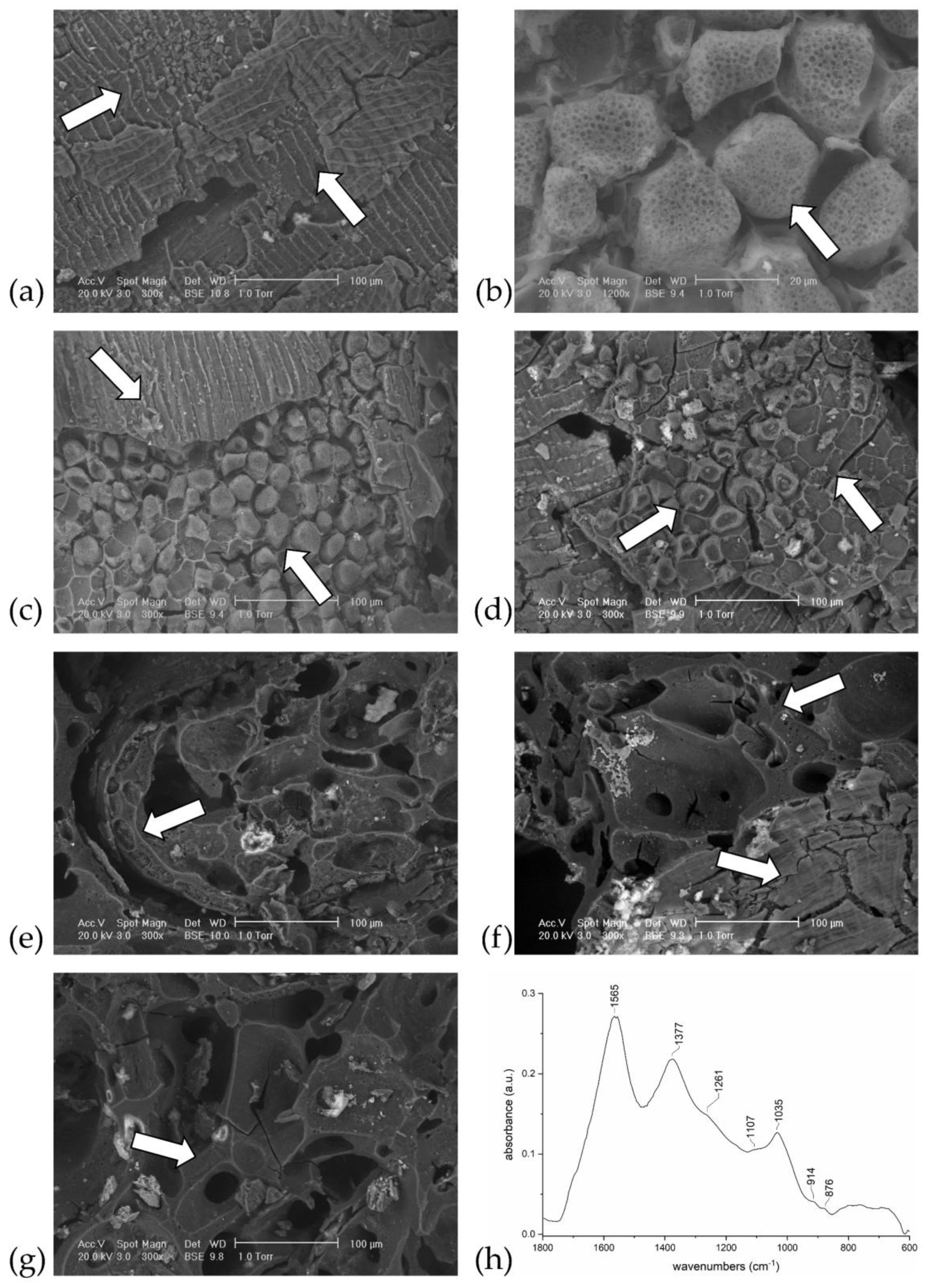The Intimate Soul of the Pyres: New Archaeological Data from the Terre di Rogo (Pyre Debris) of Pre-Roman Necropolis in Padua (Northern Italy)
Abstract
:1. Introduction
Case Studies

2. Materials and Methods
2.1. Sampling
2.2. Scanning Electron Microscopy with Energy Dispersive X-ray Spectroscopy (SEM-EDX) (SEM-EDX)
2.3. Digital Optical Microscopy
2.4. Fourier Transform Infrared Spectroscopy in ATR Mode (FTIR-ATR)
2.5. X-ray Diffraction (XRD)
2.6. Experimental Tests on Modern Animal Bones
2.7. Analysis of an Archaeological Human Bone
3. Results and Discussion
3.1. Necropolis A
3.2. Necropolis B
4. Conclusions
Supplementary Materials
Author Contributions
Funding
Data Availability Statement
Acknowledgments
Conflicts of Interest
Ethical Guidelines for the Use of Animals in Research
References
- O’Donnell, L. The Power of the Pyre—A Holistic Study of Cremation Focusing on Charcoal Remains. J. Archaeol. Sci. 2016, 65, 161–171. [Google Scholar] [CrossRef]
- Reidsma, F.H.; van Hoesel, A.; van Os, B.J.H.; Megens, L.; Braadbaart, F. Charred Bone: Physical and Chemical Changes during Laboratory Simulated Heating under Reducing Conditions and Its Relevance for the Study of Fire Use in Archaeology. J. Archaeol. Sci. Rep. 2016, 10, 282–292. [Google Scholar] [CrossRef]
- van Hoesel, A.; Reidsma, F.H.; van Os, B.J.H.; Megens, L.; Braadbaart, F. Combusted Bone: Physical and Chemical Changes of Bone during Laboratory Simulated Heating under Oxidising Conditions and Their Relevance for the Study of Ancient Fire Use. J. Archaeol. Sci. Rep. 2019, 28, 102033. [Google Scholar] [CrossRef]
- Gallo, G.; Fyhrie, M.; Paine, C.; Ushakov, S.; Izuho, M.; Gunchinsuren, B.; Zwyns, N.; Navrotsky, A. Characterization of Structural Changes in Modern and Archaeological Burnt Bone: Implications for Differential Preservation Bias. PLoS ONE 2021, 16, e0254529. [Google Scholar] [CrossRef]
- Photos-Jones, E.; Smith, B.B.; Hall, A.J.; Jones, R.E. On the Intent to Make Cramp: An Interpretation of Vitreous Seaweed Cremation “waste” from Prehistoric Burial Sites in Orkney, Scotland. Oxf. J. Archaeol. 2007, 26, 1–23. [Google Scholar] [CrossRef]
- Gherardi, F. Compositional and Morphological Investigations of Roman Glass from Cremation Deposits at Birdoswald Fort on Hadrian’s Wall, UK. Heritage 2022, 5, 362–376. [Google Scholar] [CrossRef]
- Shepherd, I.A.G.; Shepherd, A.N.; Mcdonald, A.; Powell, F.; Sheridan, J.A.; Wilthew, P.A. Cordoned Urn Burial with Faience from 102 Findhorn, Moray. Proc. Soc. Antiqu. Scotl. 2001, 131, 101–128. [Google Scholar]
- Legan, L.; Leskovar, T.; Črešnar, M.; Cavalli, F.; Innocenti, D.; Ropret, P. Non-Invasive Reflection FTIR Characterization of Archaeological Burnt Bones: Reference Database and Case Studies. J. Cult. Herit. 2020, 41, 13–26. [Google Scholar] [CrossRef]
- Lebon, M.; Reiche, I.; Fröhlich, F.; Bahain, J.-J.; Falguères, C. Characterization of Archaeological Burnt Bones: Contribution of a New Analytical Protocol Based on Derivative FTIR Spectroscopy and Curve Fitting of the ν 1 ν 3 PO4 Domain. Anal. Bioanal. Chem. 2008, 392, 1479–1488. [Google Scholar] [CrossRef]
- Thompson, T.J.U.; Gauthier, M.; Islam, M. The Application of a New Method of Fourier Transform Infrared Spectroscopy to the Analysis of Burned Bone. J. Archaeol. Sci. 2009, 36, 910–914. [Google Scholar] [CrossRef] [Green Version]
- Marques, M.P.M.; Gonçalves, D.; Mamede, A.P.; Coutinho, T.; Cunha, E.; Kockelmann, W.; Parker, S.F.; Batista de Carvalho, L.A.E. Profiling of Human Burned Bones: Oxidising versus Reducing Conditions. Sci. Rep. 2021, 11, 1361. [Google Scholar] [CrossRef] [PubMed]
- Squires, K.E.; Thompson, T.J.U.; Islam, M.; Chamberlain, A. The Application of Histomorphometry and Fourier Transform Infrared Spectroscopy to the Analysis of Early Anglo-Saxon Burned Bone. J. Archaeol. Sci. 2011, 38, 2399–2409. [Google Scholar] [CrossRef] [Green Version]
- Thompson, T.J.U.; Islam, M.; Bonniere, M. A New Statistical Approach for Determining the Crystallinity of Heat-Altered Bone Mineral from FTIR Spectra. J. Archaeol. Sci. 2013, 40, 416–422. [Google Scholar] [CrossRef]
- Snoeck, C.; Lee-Thorp, J.A.; Schulting, R.J. From Bone to Ash: Compositional and Structural Changes in Burned Modern and Archaeological Bone. Palaeogeogr. Palaeoclimatol. Palaeoecol. 2014, 416, 55–68. [Google Scholar] [CrossRef]
- Mamede, A.P.; Vassalo, A.R.; Piga, G.; Cunha, E.; Parker, S.F.; Marques, M.P.M.; Batista de Carvalho, L.A.E.; Gonçalves, D. Potential of Bioapatite Hydroxyls for Research on Archeological Burned Bone. Anal. Chem. 2018, 90, 11556–11563. [Google Scholar] [CrossRef] [PubMed]
- Mckinnon, M.; Henneberg, M.; Simpson, E.; Higgins, D. A Comparison of Crystal Structure in Fresh, Burned and Archaic Bone—Implications for Forensic Sampling. Forensic. Sci. Int. 2020, 313, 110328. [Google Scholar] [CrossRef]
- Shipman, P.; Foster, G.; Schoeninger, M. Burnt Bones and Teeth: An Experimental Study of Color, Morphology, Crystal Structure and Shrinkage. J. Archaeol. Sci. 1984, 11, 307–325. [Google Scholar] [CrossRef]
- Nicholson, R.A. A Morphological Investigation of Burnt Animal Bone and an Evaluation of Its Utility in Archaeology. J. Archaeol. Sci. 1993, 20, 411–428. [Google Scholar] [CrossRef]
- Fernández Castillo, R.; Ubelaker, D.H.; Acosta, J.A.L.; de la Rosa, R.J.E.; Garcia, I.G. Effect of Temperature on Bone Tissue: Histological Changes. J. Forensic Sci. 2013, 58, 578–582. [Google Scholar] [CrossRef]
- Ellingham, S.T.D.; Thompson, T.J.U.; Islam, M. Scanning Electron Microscopy-Energy-Dispersive X-Ray (SEM/EDX): A Rapid Diagnostic Tool to Aid the Identification of Burnt Bone and Contested Cremains. J. Forensic Sci. 2018, 63, 504–510. [Google Scholar] [CrossRef]
- Ellingham, S.T.D.; Thompson, T.J.U.; Islam, M.; Taylor, G. Estimating Temperature Exposure of Burnt Bone—A Methodological Review. Sci. Justice 2015, 55, 181–188. [Google Scholar] [CrossRef] [PubMed]
- Castelletti, L.; Castiglioni, E.; Motella, S. Antracologia Delle Terre Di Rogo. In La Necropoli Paleoveneta di via Tiepolo a Padova; Ruta Serafini, A., Ed.; Libreria ed. Zielo: Padova, Italy, 1990; pp. 148–154. [Google Scholar]
- Castiglioni, E.; Motella De Carlo, S.; Rottoli, M. Il Combustibile Nelle Cremazioni Dell’Italia Nord-Orientale. Bull. Soc. Bot. France Actual. Bot. 1992, 139, 311–318. [Google Scholar] [CrossRef] [Green Version]
- Castiglioni, E.; Motella De Carlo, S. Analisi Archeobotaniche Sulle Terre di Rogo Della Necropoli di via G.B. Tiepolo a Padova; Report in the SABAP Ve-met archive; 2012. [Google Scholar]
- Miatello, E. Macroresti Vegetali Carbonizzati Della Necropoli Paleoveneta Di Padova-via Tiepolo; Università degli Studi dell’Insubria: Como, Italy, 2011. [Google Scholar]
- Motella De Carlo, S. La Ricostruzione Del Paesaggio Attraverso Lo Studio Dei Reperti Vegetali. In La Città Invisibile: Padova Preromana: Trent’anni di Scavi e Ricerche; de Min, M., Gamba, M., Gambacurta, G., Serafini, A.R., Eds.; Edizioni Tipoarte: Bologna, Italy, 2005; pp. 48–55. [Google Scholar]
- Motella De Carlo, S. Il Significato Delle “Terre Di Rogo” per La Ricostruzione Del Paesaggio Vegetale Tra l’XI Sec. a. C. e Il II Sec. d. C. in Italia Settentrionale. In Proceedings of the Colloque de l’Association Suisse des Préhistoriens (AGUS/GPS) “Paysage… Landschaft… Paesaggio”, Geneva, Switzerland, 15–16 March 2007. [Google Scholar]
- Castiglioni, E.; Motella De Carlo, S. Padova: La Necropoli Patavina di Corso Umberto I Presso Palazzo Emo Capodilista-Scavi 2002–2003. I Risultati Delle Analisi Archeobotaniche Sulle Terre Di Rogo: Relazione Tecnica.
- Motella De Carlo, S. La Ricerca Archeobotanica e Le Terre Di Rogo. In “Presso l’Adige ridente”… Recenti Rinvenimenti Archeologici da Este a Montagnana; Bianchin Citton, E., Gambacurta, G., Ruta Serafini, A., Eds.; ADLE: Padova, Italy, 1998; pp. 54–61. [Google Scholar]
- Martinelli, E. Analisi Antracologiche e Paleocarpologiche per La Ricostruzione del Paesaggio Vegetale Durante l’Olocene in Pianura Padana: Nuovi Dati dal Sito di S. Eufemia a Padova; Università degli Studi di Milano: Milano, Italy, 2008. [Google Scholar]
- Martinelli, E.; Motella, S.; Castelletti, L. Ambiente e Ritualità Nell’area Padovana Fra Età Del Ferro Ed Età Romana: I Resti Macroscopici Vegetali Di Padova Sant’Eufemia. In Archeologia Classica e Post-Classica tra Italia e Mediterraneo. Scritti in Ricordo di Maria Pia Rossignani; Lusuardi Siena, M.S., Perassi, C., Sacchi, F., Sannazaro, M., Eds.; Vita e Pensiero: Milano, Italy, 2016; pp. 255–263. ISBN 883433115X. [Google Scholar]
- Motella De Carlo, S. I Resti Botanici Nel Pozzo. In Este Preromana: Una Città e i Suoi Santuari; Ruta Serafini, A., Ed.; Canova: Treviso, Italy, 2002; pp. 198–203. [Google Scholar]
- Gamba, M.; Ruta Serafini, A. La Necropoli Meridionale Di Palazzo Emo Capodilista-Tabacchi. In La Prima Padova. Le Necropoli di Palazzo Emo Capodilista-Tabacchi e di via Tiepolo-via San Massimo tra il IX e l’VIII sec. a. C; Gamba, M., Gambacurta, G., Ruta Serafini, A., Eds.; Archeologia Veneto: Venice, Italy, 2014; Volume 3, pp. 21–28. [Google Scholar]
- Gamba, M.; Gambacurta, G.; Ruta Serafini, A. Considerazioni Sulla Prima Padova Tra Spazio Funerario e Ritualità. In La Prima Padova. Le Necropoli di Palazzo Emo Capodilista-Tabacchi e di via Tiepolo-via San Massimo tra il IX e l’VIII sec. a. C; Archeologia Veneto: Venice, Italy, 2014; Volume 3, pp. 235–244. [Google Scholar]
- VV.AA. La Prima Padova. Le Necropoli di Palazzo Emo Capodilista-Tabacchi e di via Tiepolo-via San Massimo Tra Il IX e l’VIII Sec. a. C; Gamba, M., Gambacurta, G., Angela, R.S., Eds.; Archeologia Veneto: Venice, Italy, 2014. [Google Scholar]
- VV.AA. La Città Invisibile. Padova Preromana. Trent’anni Di Scavi e Ricerche; de Min, M., Gamba, M., Gambacurta, G., Ruta Serafini, A., Eds.; Edizioni Tipoarte: Bologna, Italy, 2005. [Google Scholar]
- Corti, C.; Rampazzi, L.; Ravedoni, C.; Giussani, B. On the Use of Trace Elements in Ancient Necropolis Studies: Overview and ICP-MS Application to the Case Study of Valdaro Site, Italy. Microchem. J. 2013, 110, 614–623. [Google Scholar] [CrossRef]
- Caputo, G. Indagine Analitica Sul Nero d’avorio Ed Altri Pigmenti Neri; Università degli Studi dell’Insubria: Como, Italy, 2017. [Google Scholar]
- Aït Kaddour, A.; Mondet, M.; Cuq, B. Application of Two-Dimensional Cross-Correlation Spectroscopy to Analyse Infrared (MIR and NIR) Spectra Recorded during Bread Dough Mixing. J. Cereal Sci. 2008, 48, 678–685. [Google Scholar] [CrossRef]
- Motella De Carlo, S.; Corti, C.; Rampazzi, L.; Brunello, V.; Castelletti, L. Food in Prehistory of Northern Italy: Case Studies and Investigation Methods. In Proceedings of the Preistoria del Cibo L’alimentazione Nella Preistoria e Nella Protostoria, Rome, Italty, 5–9 October 2015; Damiani, I., Cazzella, A., Copat, V., Eds.; Istituto Italiano di Preistoria e Protostoria: Florence, Italy, 2021; pp. 365–372. [Google Scholar]
- Styring, A.K.; Manning, H.; Fraser, R.A.; Wallace, M.; Jones, G.; Charles, M.; Heaton, T.H.E.E.; Bogaard, A.; Evershed, R.P. The Effect of Charring and Burial on the Biochemical Composition of Cereal Grains: Investigating the Integrity of Archaeological Plant Material. J. Archaeol. Sci. 2013, 40, 4767–4779. [Google Scholar] [CrossRef]
- Cohen-Ofri, I.; Weiner, L.; Boaretto, E.; Mintz, G.; Weiner, S. Modern and Fossil Charcoal: Aspects of Structure and Diagenesis. J. Archaeol. Sci. 2006, 33, 428–439. [Google Scholar] [CrossRef]
- Smidt, E.; Tintner, J.; Klemm, S.; Scholz, U. FT-IR Spectral and Thermal Characterization of Ancient Charcoals—A Tool to Support Archeological and Historical Data Interpretation. Quat. Int. 2017, 457, 43–49. [Google Scholar] [CrossRef]
- Smidt, E.; Tintner, J.; Nelle, O.; Oliveira, R.R.; Patzlaff, R.; Novotny, E.H.; Klemm, S. Infrared Spectroscopy Refines Chronological Assessment, Depositional Environment and Pyrolysis Conditions of Archeological Charcoals. Sci. Rep. 2020, 10, 12427. [Google Scholar] [CrossRef]
- Bugini, R.; Corti, C.; Folli, L.; Rampazzi, L. Roman Wall Paintings: Characterisation of Plaster Coats Made of Clay Mud. Heritage 2021, 4, 889–905. [Google Scholar] [CrossRef]
- Chukanov, N.V. Infrared Spectra of Mineral Species; Springer Geochemistry/Mineralogy; Springer: Dordrecht, The Netherlands, 2014; Volume 1, ISBN 9789400771277. [Google Scholar]
- Pandey, K.K. A Study of Chemical Structure of Soft and Hardwood and Wood Polymers by FTIR Spectroscopy. J. Appl. Polym. Sci. 1999, 71, 1969–1975. [Google Scholar] [CrossRef]
- Heiss, A.; Kreuz, A. Brot Für Die Salinenarbeiter–Das Keltenbrot von Bad Nauheim Aus Archäobotanischer Sicht. In Hessen Archaologie 2006. Jahrbuch fur Archaologie und Palaontologie in Hessen; Landesamt für Denkmalpflege Hessen: Wiesbaden, Germany, 2007; pp. 70–73. [Google Scholar]
- Heiss, A.G. Ceremonial Foodstuffs From Prehistoric Burnt-Offering Places in the Alpine Region. In Plants and people: Choices and Diversity Through Time; Chevalier, A., Marinova, E., Peña-Chocarro, L., Eds.; Oxbow Books: Oxford, UK; Philadelphia, PA, USA, 2014; pp. 343–353. ISBN 9781842175149. [Google Scholar]






| Sample Label | Tomb | US | Details | Total Number of Fragments | Bone | Starch | Possible Lignin | Minerals |
|---|---|---|---|---|---|---|---|---|
| A1 | 131 | filling of glass 3 | 5 | 3 | 0 | 4 | 5 | |
| A2 | 159 | filling of cup 12 | 1 | 1 | 0 | 1 | 1 | |
| A3 | 162 | filling of olla 3 | 1 | 0 | 0 | 1 | 1 | |
| A4 | 185 | filling of cup 14 | 5 | 3 | 1 | 4 | 5 | |
| A5 | 207 | filling of vessel 18 | 5 | 52 | 01 | 1 | 5 | |
| A6 | 207 | filling of vessel 5 | 5 | 2 | 1 | 3 | 5 | |
| A7 | 207 | 971d | external pyre debris | 5 | 3 | 1 | 0 | 5 |
| A8 | 207 | 971g | external pyre debris | 5 | 4 | 0 | 3 | 5 |
| A9 | 235 | 1120b | pyre debris above the lid of the cassette | 3 | 0 | 13 | 2 | 1 |
| A10 | 237 | 1122b | internal pyre debris above the goods | 3 | 0 | 2 | 3 | 3 |
| A11 | 273 | 1209b | internal pyre debris | 1 | 1 | 0 | 1 | 1 |
| A12 | 318 | 1346b | internal pyre debris | 1 | 0 | 1 | 1 | 1 |
| A13 | 324 | 1357b | pyre debris | 10 | 1 | 8 | 9 | 9 |
| A14 | 37 | 916b | pyre debris | 5 | 1 | 3 | 4 | 5 |
| A15 | 460 | 1722c | external pyre debris | 1 | 1 | 0 | 1 | 1 |
| A16 | 49 | small bowl 10 | 1 | 1 | 0 | 0 | 1 | |
| A17 | 581 | 1965b | internal pyre debris | 10 | 6 | 2 | 4 | 10 |
| A18 | 614 | 2044b | external pyre debris | 7 | 1 | 45 | 7 | 7 |
| A19 | 617 | 2053d | external pyre debris | 10 | 3 | 6 | 7 | 9 |
| A20 | 647 | 2134b | external pyre debris | 1 | 1 | 0 | 0 | 1 |
| A21 | 67 | 294c | filling of olla 3 | 5 | 2 | 3 | 5 | 5 |
| A22 | 672 | 2198b | internal pyre debris | 10 | 1 | 9 | 10 | 9 |
| A23 | 674 | 2204b | internal pyre debris | 5 | 2 | 2 | 2 | 5 |
| A24 | 1562 | filling of the shaft | 1 | 1 | 0 | 1 | 1 | |
| A25 | 2154 | filling of the shaft | 2 | 0 | 2 | 2 | 1 | |
| A26 | 480a | accretion of ustrinum | 1 | 1 | 0 | 0 | 1 | |
| A27 | 512 | central shaft of ustrinum | 1 | 0 | 0 | 1 | 1 | |
| A28 | 625 | central shaft of ustrinum | 1 | 1 | 0 | 0 | 1 | |
| A29 | 639 | ustrinum | 1 | 1 | 0 | 0 | 1 |
| Sample Label | Tomb | US | Details | Total Number of Fragments | Bone | Starch | Possible Lignin | Minerals |
|---|---|---|---|---|---|---|---|---|
| B1 | 50 | 458 | external pyre debris | 3 | 1 | 1 | 3 | 2 |
| B2 | 284 | 3754 | external pyre debris | 1 | 1 | 0 | 0 | 1 |
| B3 | 286 | 3805 | external pyre debris | 12 | 1 | 10 | 11 | 11 |
| B4 | 287 | 78/79 | internal pyre debris | 6 | 2 | 3 | 6 | 6 |
| B5 | 289 | 3774b | external pyre debris | 6 | 6 | 0 | 6 | 6 |
Disclaimer/Publisher’s Note: The statements, opinions and data contained in all publications are solely those of the individual author(s) and contributor(s) and not of MDPI and/or the editor(s). MDPI and/or the editor(s) disclaim responsibility for any injury to people or property resulting from any ideas, methods, instructions or products referred to in the content. |
© 2023 by the authors. Licensee MDPI, Basel, Switzerland. This article is an open access article distributed under the terms and conditions of the Creative Commons Attribution (CC BY) license (https://creativecommons.org/licenses/by/4.0/).
Share and Cite
Corti, C.; Motella De Carlo, S.; Rampazzi, L. The Intimate Soul of the Pyres: New Archaeological Data from the Terre di Rogo (Pyre Debris) of Pre-Roman Necropolis in Padua (Northern Italy). Heritage 2023, 6, 849-866. https://doi.org/10.3390/heritage6020047
Corti C, Motella De Carlo S, Rampazzi L. The Intimate Soul of the Pyres: New Archaeological Data from the Terre di Rogo (Pyre Debris) of Pre-Roman Necropolis in Padua (Northern Italy). Heritage. 2023; 6(2):849-866. https://doi.org/10.3390/heritage6020047
Chicago/Turabian StyleCorti, Cristina, Sila Motella De Carlo, and Laura Rampazzi. 2023. "The Intimate Soul of the Pyres: New Archaeological Data from the Terre di Rogo (Pyre Debris) of Pre-Roman Necropolis in Padua (Northern Italy)" Heritage 6, no. 2: 849-866. https://doi.org/10.3390/heritage6020047





